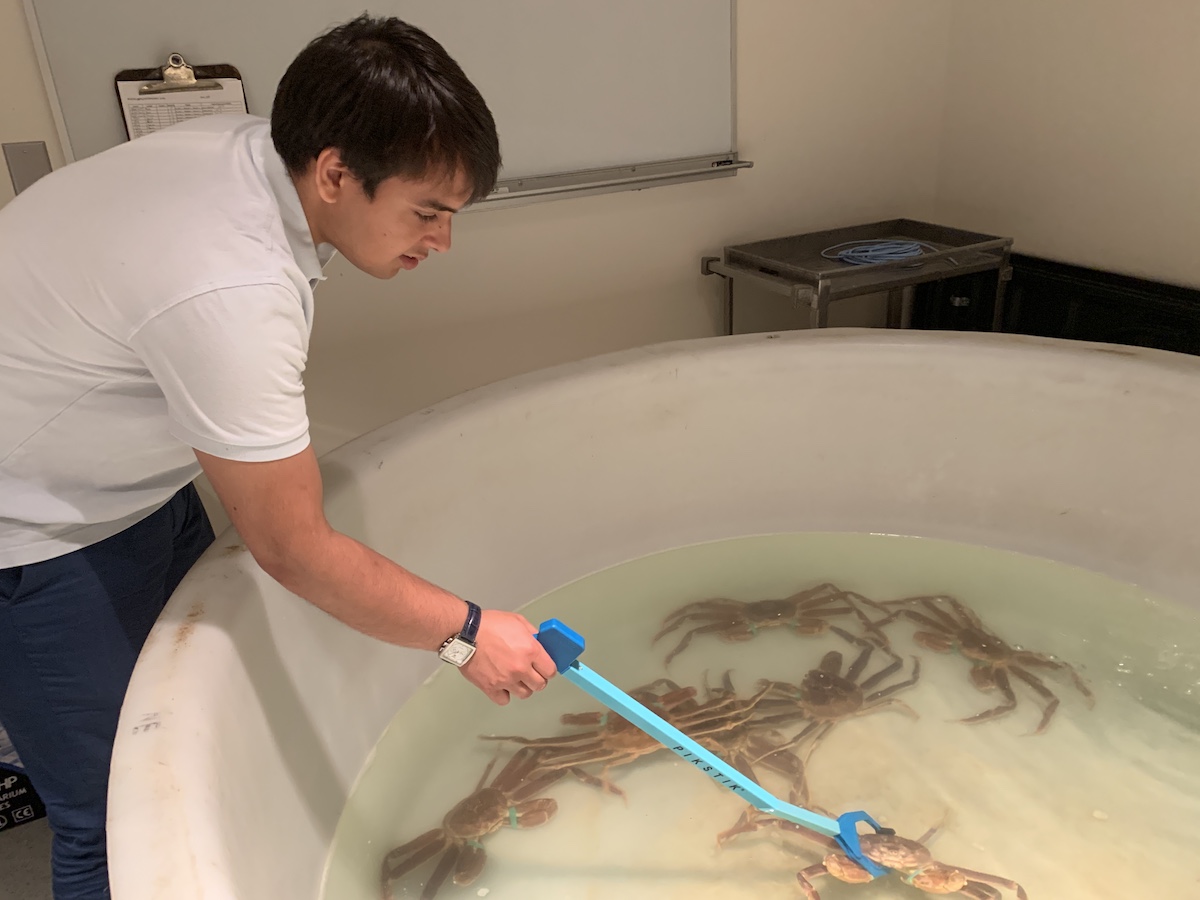Jacob Kazmi ’20 Studies a Possible Driver of Diet Preferences
By Rebecca GoldfineThis summer, approximately fifty-five students have Bowdoin fellowships to work on mentored independent projects in one of the biology, chemistry, biochemistry, or neuroscience labs run by faculty in Druckenmiller Hall.

Senior Jacob Kazmi has funding from two sources—a Paller Neuroscience Research Fellowship, through Bowdoin, and a Maine INBRE Research Fellowship—to work in the lab of Patsy Dickinson, Bowdoin's Josiah Little Professor of Natural Sciences. He's one of a team of students helping Dickinson learn more about central pattern generators.
And central pattern generators are what, exactly? "That's a fancy word for a group of neurons that work together to stimulate muscles with rhythmic patterns," Kazmi explained. "The most common examples of central pattern generators are the networks that control the digestive system, walking, flying—rhythmic behaviors that require rhythmic outputs."
Central pattern generators are easier to study in organisms with relatively simple nervous systems, like lobsters and crabs. Kazmi is working with a large, lethargic, cold water crab found in Nova Scotia called the snow crab.
(To gather his subjects, Kazmi drove nine hours to Halifax, Nova Scotia, to buy live crabs from fishing boats pulling in with fresh catch. Snow crabs are a delicacy in Japan, and are quite expensive. He used some of his fellowship money to buy thirty crabs for $500, rushing them back to Brunswick to keep them alive.)
While scientists like Dickinson are making advances in understanding central pattern generators in general by studying crustaceans, scientists aren't yet sure how central pattern generators in humans work. Some wonder whether targeting what is believed to be a central pattern generator in the base of our spines could unlock the secret to reversing paralysis. Central pattern generators may also play a role in sudden infant death syndrome, or SIDS, when infants stop breathing without explanation.
Taking a closer look at the variability of central pattern generators and diet preferences
Kazmi's project looks at whether the crabs' pattern generators are somehow connected to their diet preferences, helping to explain why some crabs are vegetarians and some are not. For example, the tiny northern kelp crab only feeds on seaweed, while the snow crab is an omnivore, eating whatever floats down to the bottom of the sea.
Kazmi suspects that chemical compounds called neuromodulators in the crabs' guts have evolved to control the speed at which central pattern generators fire. This electrical activity in turn controls the contractions of the muscles in the digestive system that break down food.
"It is logical that the more different types of food you eat, the more different types of muscle movements you would need to break down those foods," he said. So, while a vegetarian crab might respond to three to five neuromodulators in their stomach, an omnivore snow crab might be responding to double that amount.
Dickinson said that it could be the more varied diet of snow crabs has driven the evolution of more modulators. "Or," she continued, "the kelp crabs have lost that flexibility over evolutionary time. My guess is that the direction of the relationship is from diet to central pattern generator, rather than central pattern generator to diet."
To continue work in this area, Dickinson has recently won a grant from the National Science Foundation to address two fundamental questions related to Kazmi's neuromodulator research. First, on an evolutionary timescale, she wants to find out which variables determine the extent to which networks can be modulated, and second, she wants to discover the factors or mechanisms that underlie differences in modulatory capacity.
"Rhythmic movements such as heartbeat and locomotion [controlled by networks of nerve cells and neuromodulators] must be flexible to allow animals to alter their behavior in response to changing conditions," she explained. And "there is evidence that the extent to which similar networks can be altered (modulatory capacity) varies among species."
Kazmi plans to extend his summer project into an honors thesis over the academic year. His long-term plan is to go to medical school and ideally stay involved in research, perhaps in the area of psychedelic treatments for psychiatric disorders.
Summertime positions in Bowdoin labs offer invaluable experiences for students to grow as scientists and gain research skills, as faculty give them the freedom "to develop their own projects, think through research, and work independently," Dickinson said. "The opportunity for students is amazing," she added.



